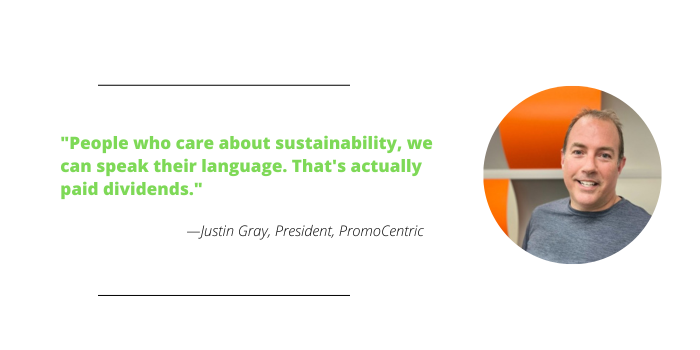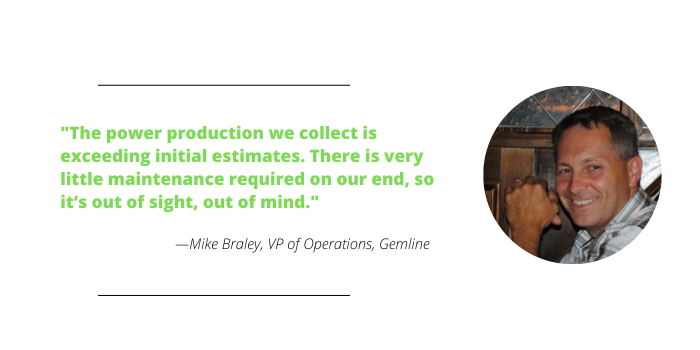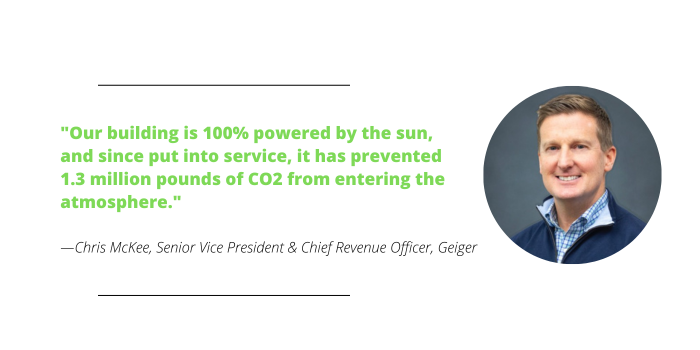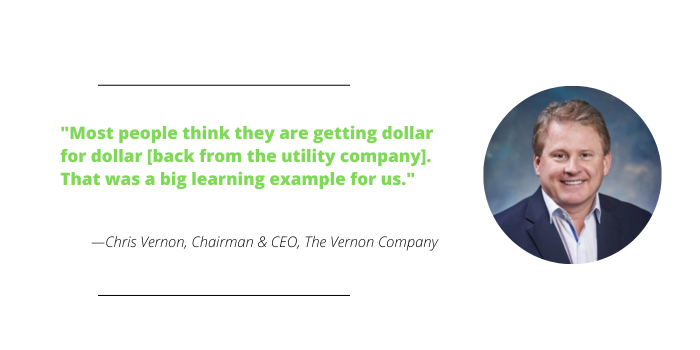You can see them from the turnpike before you even reach the exit that would take you to Geiger’s headquarters. All 696 of them; the largest array of solar panels of any privately held firm in the state of Maine.
Travel to Missouri and you might need a helicopter to see them atop The Vernon Company’s production facility. But if you get high enough, you’ll see roughly 900 solar panels catching that Midwestern sun.
Both Geiger and The Vernon Company are family-run businesses, multiple generations into their existence. It might be tempting to think they’d be focused on ideas like “tradition” and an overreliance on what has worked as opposed to what could be done differently.
But forward thinking is a common trait of companies that have been as successful for as long as these two distributors. Over time, that kind of foresight evolves. We’re not just talking about how an investment might benefit the company next year. We’re talking about how a series of decisions might benefit the next generation of stakeholders, and possibly create better circumstances for the grandchildren of employees and customers alike.
“We’re trying to be a sustainably responsible family business in an industry that was traditionally looked at as kind of bad for the environment,” says Chris Vernon, chairman and CEO of The Vernon Company.
As the promo industry continues its strides in shedding that prior reputation through higher quality and reusable products, more and more companies are looking toward powering their properties through solar panels.
There’s no one-size-fits-all approach to solar panels. Myriad factors, approaches and incentives determine the right method for any given company. But different approaches are tending to produce similar results: long-term financial gains.
The promo industry is full of individuals who rarely fail to take advantage of an opportunity. This particular opportunity is one you can see almost every time you look out your office window.

‘Three-Fold’ Motivation
Justin Gray knew that installing solar panels for PromoCentric Inc. in New Hampshire, where he resides as president, was an investment. And not a cheap one, at that. According to Gray, installing the panels at PromoCentric’s headquarters cost roughly $500,000 in cash.
But by the time the decision was made, he’d come to the conclusion that the payoff would be multi-pronged.
“It’s three-fold, really,” Gray says. “There’s the eco-factor. It’s a revenue generator, and there’s a marketability, if you will.”
It’s been a little over a year since the installation finished, and Gray can speak to the power of that marketability.
“People who care about sustainability, we can speak their language,” Gray says. “That’s actually paid dividends. We’ve done quite a bit of business with solar companies, for example.”
Vernon agrees that they have clients who aren’t afraid to ask, “What are you doing in terms of ESG?”
The answer, if you’ve installed solar panels, is “a lot.”
Solar power works by converting natural sunlight into electrical energy, typically through photovoltaic panels. According to Energy.gov, the amount of sunlight that touches the earth’s surface in 90 minutes is enough to power the world for one year. This renewable and infinite source of energy is an easy and efficient way to offset carbon emissions, and its processes do not emit pollutants, therefore it does not contribute to climate change the way burning fossil fuels does.
The solar panels at Geiger’s headquarters, for example, eliminate about 320,000 pounds of carbon pollution from fossil fuel power plants every year, according to the company. “Our building is 100% powered by the sun, and since put into service, it has prevented 1.3 million pounds of CO2 from entering the atmosphere,” says Chris McKee, senior vice president and chief revenue officer at Geiger.
We will get into a few of the specific nitty-gritty details that companies need to consider when going in the direction of installing solar panels a little later, but the primary question that comes with any significant investment in a form of technology is obvious: Is it worth it?
The answer from every company PPAI Media spoke to was a unanimous yes.
“The investment was certainly substantial,” says Mike Braley, Gemline’s VP of operations. “But the long-term impact on the environment and a reasonably good payback made it an easier decision at the end of the day.”
Payback times will vary depending on initial investment, state policies and a host of other factors, but even with different experiences and choices, every promo company that spoke to PPAI Media is happy with the product installed, turning the payback period into a simple waiting game, barely different than operations pre-installation.
“The power production we collect is exceeding initial estimates and is therefore performing above our expectations,” Braley says. “There is very little maintenance required on our end, so it’s out of sight, out of mind.”
For reference, Geiger’s initial payback time for their roughly $550,000 investment was 13 years, “and we’re right on target,” McKee says. The Vernon Company’s payback time was estimated at six or seven years and was later pushed to eight or nine based for reasons we will get into later, a development that that caused no regrets in the mind of Vernon, but that caused no regrets in Vernon’s mind.
Gray used the word “no-brainer” when the numbers for PromoCentric’s 560 panels were in front of him. He sees it as an investment that goes away after seven years.
“And then it’s a positive cash flow of whatever it ends up being,” Gray says. “I think it was like $75,000 a year is what was calculated based on the square footage.”
The precedents for financial profit are numerous. They aren’t exactly up for debate in the big picture. But how much gain, how many panels, where they are installed or whether your circumstances allow you to simply save money or actively generate it? Those are all decisions that will require homework and consultation.

What Do You Need To Know?
Vernon compares going through the process of installing solar panels to buying your first home.
“I would never give up the opportunity to be a homeowner,” Vernon says, adding that he is more keenly aware of what he wants in a home purchase than he was when he bought his first home.
Perhaps the most important decision a promo company can make when considering solar panel installation is correctly determining who to partner with or solicit consultation from. Vernon recommends doing some background on the vendor.
“Are they going to be around in 20 years if you have problems?” Vernon asks. “Because we have, I believe, a 25-year guarantee on the system. Are they going to service that if something goes wrong?”
McKee agrees that going in cold could lead to costly mistakes.
“Most important in this process is working with a solid partner to plan the system to be sure the size is correct, and that you’re going to realize the goals you’ve put in place,” McKee says.
Suparna Kadam, VP of business development for Pivot Energy, a national provider and consultant for solar services, says one of the biggest mistakes she sees from businesses hoping to install solar panels is their temptation to think they can purchase them the way they purchase the products or supplies used in their everyday business.
“A lot of companies that we deal with will have their procurement teams go out and try to buy solar, and they treat it just like buying screwdrivers,” Kadam says. “It’s really not that. So, you need to treat it a little differently.”
Where the panels should be installed will depend on the specifics of your building, and what approach will realize the most financial gains could very well depend on what state you’re in. Some states will allow for sales or property tax exemptions with solar energy. Federal grants are a possibility, too.

No matter what state your company is located in, financial savings are possible through solar energy, but according to Kadam, states that most incentivize it in 2023, through varying possibilities, are currently California, Illinois, Massachusetts, New York, Maryland, Connecticut and New Jersey.
All of this is fluid, however, and that is largely due to something called “net metering,” a practice simple in concept but applied significantly differently based on a given region. In its most simple terms, net metering can be broken down as follows:
Your solar panels are likely to produce more energy than you actually need to power your facility. That extra energy can be sold back to the grid at a profit. In an ideal world, a utility company credits that excess power at the retail price they would normally charge, and sometimes that will be the case. Unfortunately, promo companies have learned that any given solar power generator is at the mercy of the utility company whose jurisdictions they are under.
“Most people think they are getting dollar for dollar [back from the utility company],” Vernon says. “That was a big learning example for us.”
For this reason, the vendor The Vernon Company used recommended building the solar panels to provide only about 70% the power needed for the facility, rather than spending for panels that generate excess energy and getting a bad deal from its grid. This development resulted in extending payback for the facility’s solar panels by potentially two years.
Even in New Hampshire, Gray realized that the utility company was being “stingier on purpose” with its approach to net metering. In a normal transaction, PromoCentric’s utility group charges for supply and for delivery. Even if PromoCentric is the one sending power out, the delivery charge remains the promo company’s burden.
“It does extend the payoff,” Gray says. “And I have to imagine they’re going to keep doing that as time goes by because obviously, they’re going to keep losing revenue. They’re going to do what they have the power to. I mean, they’re a monopoly, right?”
“It can vary by utility and state, so it is very much patchwork,” Kadam says.
But even with these inconsistent policies, easily generating your own power rather than relying on a utility company is a money saver. Cutting into a monopoly can allow you additional solutions, one of which is battery storage, something Chris Vernon says his company is actively considering.
Instead of putting that excess power into the grid, a company with solar panels can store it on a battery, and thus hold it for when they need it. The sun only shines during the day, but why rely on the utility company at night when the daylight hours should typically supply all the power you need?
“So, you don’t have to worry about sending energy to the grid,” says Kacie Peters, director of industry relationships for Pivot Energy. “You’re using it, storing it and then using it again.”
It is, of course, also possible for a supplier to partner with a plant that already installed solar panels, as SanMar did with a factory plant in Honduras called Elcatex, which SanMar eventually made an equity investment in and went on to buy half of the company. Emily Gigot, SanMar’s senior manager of sustainability, says the plant has seen cost benefits due to the lower cost of power generated from solar compared to other fuels. Solar panels at additional locations is a possibility being explored.
“Our supplier is able to track the environmental benefits of solar based on the carbon emissions avoided for every kilowatt hour of electricity generated by solar versus an alternate source,” Gigot says.
While it takes a significant investment to install hundreds of panels to generate the kind of power we’ve discussed, solar energy is infinite and renewable. There are efficient ways to save money, even at smaller scales.
“One is community solar,” Peters says. “They’re subscribing to an offsite project. These are projects that are typically at least within their state, if not within their local geography. And they’re getting a discount to their energy bill, just for participating in that.”
These are the conversations that can take place in an initial consultation with a reputable solar provider.

‘You Can Go As Sophisticated As You Want With This Stuff’
It’s possible that you looked into solar panels five or six years ago and determined it was not the right move financially. Peters says it might be time to look again.
“I’d encourage folks who’ve looked into solar a few years ago, to maybe give it a second look now, considering the inflation Reduction Act [2022] and all the different incentives that follow there,” Peters says.
A large-scale solar panel installation might take about 12-18 months from initial conversation to fully constructed. Pivot Energy, for example, warranties its panels for 25 years. After that time, they should be producing at 80% what they originally were. Kadam expects them to produce in a viable way for over 40 years.
Whether you’re looking to install hundreds of panels, reap tax incentives, use net metering to generate profit, store energy on a battery, or create systems that track your power usage with reports better than your utility company could provide, the possibilities will continue to be innovated.
“You can go as sophisticated as you want with this stuff,” Vernon says.
And Gray reminds us that you are not required to choose between solar power and the grid.
“We’re still connected to the grid,” Gray says. “It’s failsafe from a liability perspective. It’s not like if it gets cloudy, you lose electric.”
All of this is underscored by the environmental benefits.
“It’s just the right thing to do,” Vernon says.
Geiger is planning to add additional panels to its current solar array. The Mandalay Bay Convention Center, where The PPAI Expo is held, is powered by solar panels.
If the promo industry’s future was already looking bright, then perhaps harnessing some of the brightest moments for power would be fitting. As long as the sun is shining, it’s there to be utilized.


